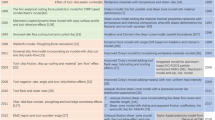Abstract
The consideration of the dynamic interaction between the machine tool structure and the cutting process is a prerequisite for the simulative prediction and optimization of machining tasks. However, existing cutting force models are either dedicated to already examined manufacturing operations or require extensive measurements for the determination of cutting coefficients. In this context this paper outlines a modular, analytical cutting force model applicable to common turning processes. It takes into account the dynamic material behavior, nonlinear friction ratios on the rake face as well as heat transfer phenomena in the deformation zones. On the part of the machine tool structure a parametric model based on the Finite Element Method (FEM) is implemented. Both models are coupled for the simulation of process and structure interactions, whereas the influence of the control system is considered as well. The simulation results were verified experimentally on a turning center.









Similar content being viewed by others
References
Iqbal S, Mativenga P, Sheikh M (2007) Characterization of machining of AISI 1045 steel over a wide range of cutting speeds. Proc IMechE 221:917–926
Van Luttervelt CA, Childs THC, Jawahir IS, Klocke F, Venuvivod PK (1998) Present situation and future trends in modelling of machining operations. Ann CIRP 47(2):587–626
Oxley PLB (1989) The mechanics of machining: an analytical approach to assessing machinability. Ellis Horwood Limited, Chichester
Hoppe S (2003) Experimental and numerical analysis of chip formation in metal cutting. Dissertation RWTH Aachen
Merchant ME (1945) Mechanics of the metal cutting process, II. Plasticity conditions in orthogonal cutting. J Appl Phys 16:318–324
Armarego EJA, Whitfield RC (1985) Computer based modelling of popular machining operations for force and power predictions. Ann CIRP 34:65–69
Altintas Y (2000) Manufacturing automation. Cambridge University Press, Cambridge
Waldorf D, DeVor R, Kapoor S (1999) An evaluation of ploughing models for orthogonal machining. Trans ASME 121:550–558
Wang J, Mathew P (1995) Development of a general tool model for turning operations based on a variable flow stress theory. Int J Mach Tools Manuf 35:71–90
Yen Y, Jain A, Altan T (2004) A finite element analysis of orthogonal machining using different tool edge geometries. J Mater Process Technol 146:72–81
Zaeh MF, Schwarz F (2008) Consideration of tool and workpiece temperatures in a modular cutting force model. In: Proceedings of the 1st International Conference on Process Machine Interactions
Jaspers S, Dautzenberg JH (2002) Material behaviour in conditions similar to metal cutting: flow stress in the primary shear zone. J Mater Process Technol 122:322–330
Zerilli F, Armstrong R (1987) Dislocation-mechanics-based constitutive relations for material dynamics calculations. J Appl Phys 61(5):1816–1825. doi:10.1063/1.338024
Zerilli F (2004) Dislocation mechanics-based constitutive equations. Metall Mater Trans A 35 A:2547–2555
Özel T (2006) The influence of friction models on finite element simulations of machining. Int J Mach Tools Manuf 46:518–530
Childs THC (2006) Friction modeling in metal cutting. Wear 260:310–318
Sartkulvanich P, Koppka F, Altan T (2004) Determination of flow stress for metal cutting simulation: a progress report. J Mater Process Technol 146:61–71
Zaeh MF, Oertli T (2004) Finite element modelling of ball screw feed drive systems. Ann CIRP 53(1):289–293
Zaeh MF, Oertli T (2005) Parametric finite element modelling of machine tool structures. Prod Eng XII(1):129–132
Zäh MF, Schwarz F (2007) Arbeitsraumstudien bei Werkzeugmaschinen - Untersuchung des stellungsabhängigen Strukturverhaltens mit der Finite-Elemente-Methode. ZWF Innovationen im Werkzeugmaschinenbau 102:7–8
Zaeh MF, Oertli T (2004) FEM analysis and control system simulation of ball screw feed drive systems in machine tools. In: Proceedings of NAFEMS Seminar on Mechatronics in Structural Analysis, Paper No. 9
Acknowledgments
We extend our sincere thanks to the German Research Foundation (DFG) for the generous support of the work described in this paper.
Author information
Authors and Affiliations
Corresponding author
Rights and permissions
About this article
Cite this article
Zaeh, M.F., Schwarz, F. Implementation of a process and structure model for turning operations. Prod. Eng. Res. Devel. 3, 197–205 (2009). https://doi.org/10.1007/s11740-009-0158-0
Received:
Accepted:
Published:
Issue Date:
DOI: https://doi.org/10.1007/s11740-009-0158-0



